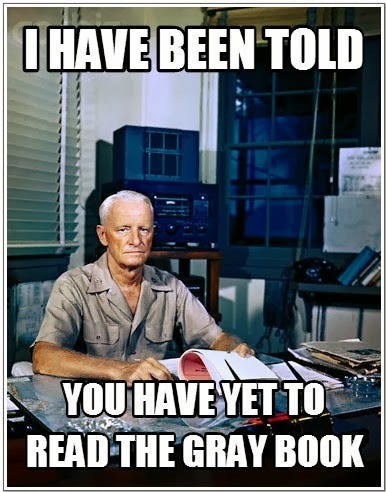Fullbore Friday
...the many and his moment...
Through almost years of FbF, we have covered a lot of WWII stories. Most of those stories came from the Pacific. For the day after Pearl Harbor Day, it is time to reach back nine years in to the archive for a goodie.
The war in the Pacific was led by a truly unique leader - almost mythological to the point he has his own meme.
For those of us who are WWII history buffs, something intellectually Fullbore took place in 2014 - something we all owe a tip of a hat to the team that brought this about.
The Naval War College Library in Newport, R.I. publicly unveiled online the 4,000-page “Gray Book” collection of Fleet Adm. Chester Nimitz communications that started in the wake of the Pearl Harbor attack and ran right up until the closing days of the war. The event was held Monday, Feb. 24 at 6:30 p.m. Eastern.
The event was held on the anniversary of Nimitz’ 129th birthday. It featured a lecture discussing the Gray Book as well as a question & answer session with U.S. Naval Academy Professor of History Emeritus Craig L. Symonds, PhD, author of numerous books including “The Battle of Midway,” in which he recounts the pivotal role played by Nimitz in what was the turning point of the war in the Pacific.
...
Naval History and Heritage Command’s (NHHC) Operational Archives, which possesses the physical collection, provided expertise and support to the Naval War College effort to publish the high-quality digital version of the documents.
The WWII historic treasure, named for the color of its original cover, is a daily record of the combat situation in the Pacific Theater and responses of the Commander in Chief, Pacific, and Pacific Ocean Areas (Nimitz) throughout the War. Staff-member Capt. James Steele began it on the day Pearl Harbor was attacked and ended it on Aug. 31, 1945, just two days before the formal end of the war.
“I’ve seen the collection and it’s really a national treasure,” said Capt. Henry Hendrix, Ph.D., director of the Naval History and Heritage Command. “They clearly reveal what Nimitz thought was important, which gives the reader a great deal of insight into how his experiences both operationally and at the Naval War College informed and influenced his prosecution of the war. I’m extremely pleased we can now share it with researchers, the American public, and Sailors past and present. I’m eager to see the collection discussed and to demonstrate the continued relevance of leveraging history in the decision making process.”
Nimitz was assigned to relieve Adm. Husband Kimmel, and arrived in Pearl Harbor on Christmas Day, 1941. Nearly three years later, he was advanced to the newly created rank of Fleet Admiral – five stars. Less than a year later, Sept. 2, 1945, he signed the instrument of the Japanese surrender aboard the battleship USS Missouri (BB 63) in Tokyo Bay.
Here's the video. While you are watching it, you can get the "Gray Book" for free from both the Pacific War Museum and ibiblio, as I can no longer find the link to it from the Naval War College.
From the 1:10 point;
"... the process of decision making ... must be open, must have interchange. You must be able to subordinate your own personal ego to the issues that are under consideration. ... The characteristics that Nimitz brought to the decision making process ... If all leaders in uniform and civilian clothes, can keep in mind Chester Nimitz as a model for decision making process, I think we would all be better off."
- Professor Craig L. Symonds, PhD
BZ to all involved.
As a side note, if you’d like to hear more from Dr. Symonds, if you have not already, check out the limited run podcast I hosted 7 years ago, The Warrior Writers, in conjunction with the U.S. Naval Academy Museum and the U.S. Naval Institute.
Great stuff.




Nimitz was a giant. A modest man. He could be fiercely loyal (Halsey and Spruance) and he could also respect loyalty from his subordinates when pressure was on to fire certain officers Ie. (Halsey defending Fletcher and Stanhope Ring).
His ability to delegate without getting into the micro and macro was the key to his success. He had confidence in his own abilities and empowered his staff to exude the same confidence without arrogance. He was the perfect foil to King’s arrogance and ego. I believe he carried King through the war.
A lot could be learned by todays flag officers. They should strive to be more like Nimitz. If they did, things would naturally change for the better in our Navy.
Excellent. Wonder if the other 4 and 5 stars left similar records. I worked for a Chief of Staff, Army, who kept a daily diary of his interactions taken from his daily calendar. Took daily calendar and diary home with him every night to capture his impressions and decisions/estimates and brought it back to his safe every morning. Said he didn't want future historians to guess or surmise or assume his motivations, communications, or decisions.
I live near the Museum of the Pacific. Absolutely strong recommendation if you are ever in the San Antonio or Austin areas. They took Nimitz' family hotel in Fredericksburg and renovated/expanded the site into the museum. Stellar work taking you through the war in the Pacific. Outdoor courtyard lined with plaques from ship associations commemorating many of the ships involved. Back entrance landscaped with conning tower coming out of rolling green ground cover shaped like waves. Really inspiring stuff.